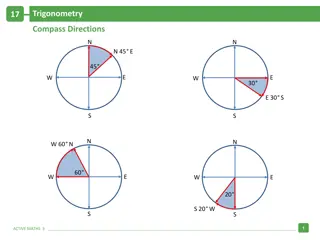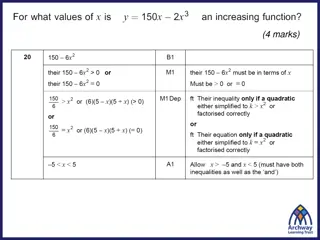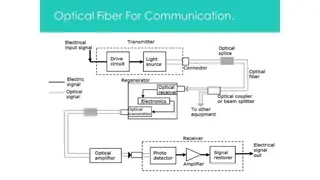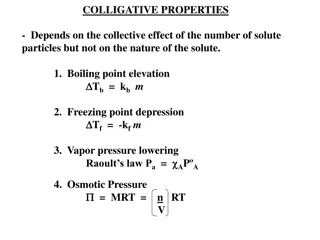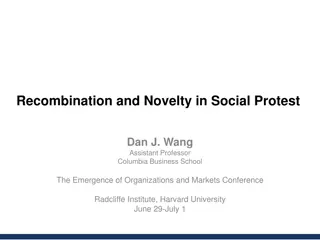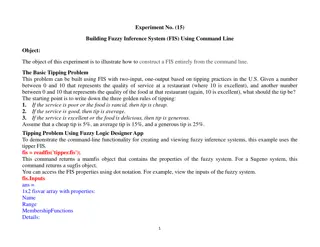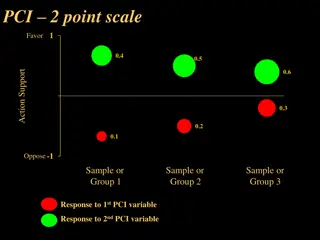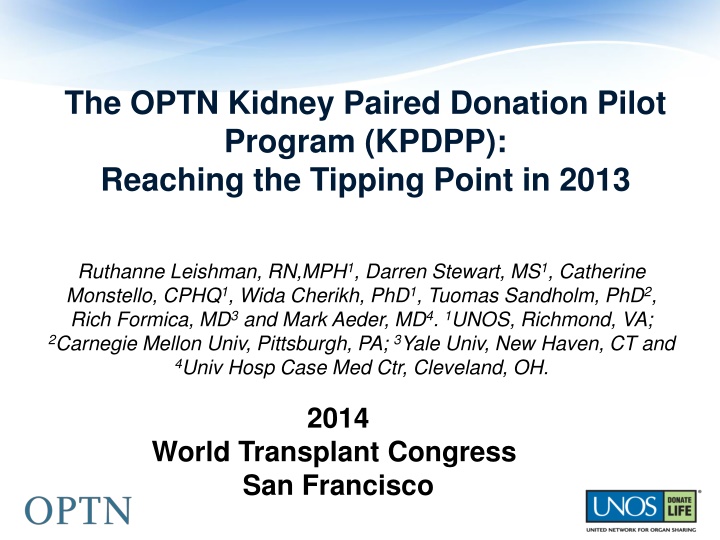
OPTN Kidney Paired Donation Program Analysis 2013
Explore the progress and impact of the OPTN Kidney Paired Donation Pilot Program in 2013, showcasing increased participation, match offers, and transplants. Financial disclosures and acknowledgments are highlighted, along with insights into reaching a tipping point in innovation theory. Discover the region programs' participation and the rapid rate of adoption of the OPTN KPDPP, leading to a significant rise in kidney transplants.
Download Presentation

Please find below an Image/Link to download the presentation.
The content on the website is provided AS IS for your information and personal use only. It may not be sold, licensed, or shared on other websites without obtaining consent from the author. If you encounter any issues during the download, it is possible that the publisher has removed the file from their server.
You are allowed to download the files provided on this website for personal or commercial use, subject to the condition that they are used lawfully. All files are the property of their respective owners.
The content on the website is provided AS IS for your information and personal use only. It may not be sold, licensed, or shared on other websites without obtaining consent from the author.
E N D
Presentation Transcript
The OPTN Kidney Paired Donation Pilot Program (KPDPP): Reaching the Tipping Point in 2013 Ruthanne Leishman, RN,MPH1, Darren Stewart, MS1, Catherine Monstello, CPHQ1, Wida Cherikh, PhD1, Tuomas Sandholm, PhD2, Rich Formica, MD3and Mark Aeder, MD4. 1UNOS, Richmond, VA; 2Carnegie Mellon Univ, Pittsburgh, PA; 3Yale Univ, New Haven, CT and 4Univ Hosp Case Med Ctr, Cleveland, OH. 2014 World Transplant Congress San Francisco
Financial Disclosure Statement I have no financial relationships to disclose within the past 12 months relevant to my presentation.
Acknowledgments This analysis reflects work performed on behalf of and in conjunction with the OPTN Kidney Transplantation Committee and the KPD Work Group. This work was supported wholly or in part by Health Resources and Services Administration contract 234- 2005-370011C. The content is the responsibility of the authors alone and does not necessarily reflect the views or policies of the Department of Health and Human Services, nor does mention of trade names, commercial products, or organizations imply endorsement by the U.S. Government.
Background The OPTN KPDPP was launched in 2010 Centers enter candidates & donors into online system Algorithms search for 2-way/3-way/chain exchanges Policy and online system enhancements continue Increases in participation, match offers, & transplants Analyses based on OPTN KPD database
Region Programs/ Region 1 Participation by Region 14/14 http://insideunos/life/PublishingImages/UNOSRegions.jpg 21/30 2 7/22 3 19/28 4 15/30 5 3/9 6 17/22 7 11/18 8 9/13 9 12/19 10 10/22 11 138/228 Total
The Tipping Point Innovation Theory
The Diffusion Curve: Reaching the Tipping Point 100 90 80 70 % Adopted 60 50 40 30 20 Tipping Point 10 0 Time Innovation Theory
Rate of Adoption of the OPTN KPDPP Tipping Point
Sharply Increasing Number of Transplants 120 110 100 79 80 60 40 27 17 20 2 0 As of July 24: 110 transplants
Improving Match Success Rates Rolling 12-Month (Approximate*) Match Success Rates, Since 2012 Includes Match Runs from Jan 2012 April 2014 Success Rate = Transplants/Matches produced by algorithm (Matches resulting from a manual repair not included in denominator) 16% 14.8% 14% 12% 10.8% 10.0% 10% 8.6% 8% 7.1% 5.4% 6% 4% 2% 0% Success rates have improved, but work still needed. Overall, about 10% of matches resulting in transplant.
Matches Found Per Month Average of 44 match offers sent per month in 2014.
Trends in Candidates Added to OPTN KPD System Over 1,000 candidates have been added so far.
Average # of Eligible Candidates and Donors per Match Run Consistently ~250 pairs entered into each match run.
Eligible Candidates by Program Wide range in participation among the 98 programs.
Summary Increase hospital participation Increase number of pairs = Increase number of transplants 120 110 100 79 80 60 40 27 17 20 2 0
Conclusion The OPTN KPDPP is a robust, increasingly successful KPD program available to all LKD programs. Reached a tipping point with the majority of the U.S. LD transplant programs participating Reached another tipping point with 52 transplants in 2013 Consistent pool of around 250 pairs for each match run Continue to work on ways to increase the match success rate
2013-2014 KPD Work Group Nancy Reinsmoen, Ph.D, D(ABHI) Mark Aeder, MD (Chair) John Friedewald, MD Pat McDonough, RN, CPTC, CCTC Richard Formica Jr., MD Michael Rees, MD, Ph.D Adam Bingaman, MD, Ph.D Mike Gallichio, MD Mary Amanda Dew, Ph.D Eric Gibney, MD Matthew Cooper, MD Alvin Roth, Ph.D Lloyd Ratner, MD Stuart Flechner, MD, JSWG Chair Mariza Turner, RN Sommer Gentry, Ph.D, TA Mary Leffell, Ph.D Tuomas Sandholm, Ph.D, TA Gene Ridolfi Itai Ashlagi, Ph.D, TA JSWG = Joint Societies Work Group; TA = Technical Advisor






